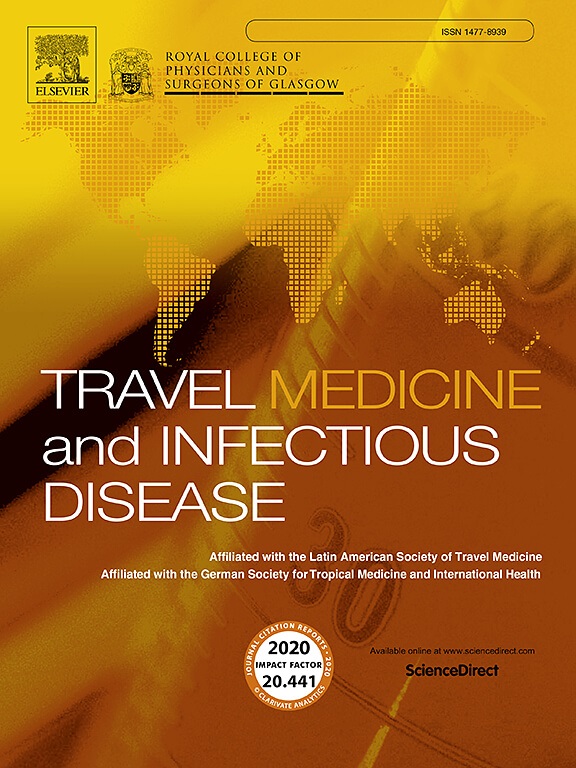中东和北非地区移民人群结核病的负担、临床结果和特征:一项系统综述和荟萃分析
IF 4.7
3区 医学
Q1 INFECTIOUS DISEASES
引用次数: 0
摘要
由于社会经济和结构性障碍,中东和北非(MENA)地区的移民面临着更高的结核病(TB)风险。本系统综述综合了有关中东和北非地区移民结核病负担、临床结果和流行病学特征的证据。方法检索6个电子数据库和灰色文献来源,检索2000年至2024年9月期间发表的各种语言的研究。符合条件的研究报告了移民中结核病患病率、发病率、治疗结果以及临床或流行病学特征的初步数据。使用DerSimonian &;Laird的随机效应模型(如果适用)或叙事合成。在确定的779项记录中,我们纳入了57项研究,包括12个中东和北非国家的95190例结核病病例和3532359名移民。移民的结核病发病率始终高于非移民(26.7 - 69.8/10万vs 11.5 - 16.8/10万)。移民的结核病相关死亡率较低(合并OR为0.8,95% CI为0.7-0.9;I2 = 2.9%),然而,治疗成功率始终低于世卫组织推荐的90%阈值。移民结核病患者更年轻(平均年龄差:12.8岁;95% ci 8.8-16.0;I2 = 86.5%),以男性为主(性别比例:1:5)。耐药结核病在移民中更为常见,尽管这并不总是具有统计学意义(多药耐药结核病:汇总OR 1.2;95% ci 0.9-1.6;I2 = 40.2%),而肺外结核在非流动人口中更为普遍(33.4 - 83.4%比16.6 - 72.9%)。结论中东和北非地区的移民面临着不成比例的结核病负担和较差的治疗结果,强调了有针对性干预措施的必要性。加强数据,特别是来自北非的数据,对于支持符合世界卫生组织和可持续发展目标的区域消除结核病至关重要。本文章由计算机程序翻译,如有差异,请以英文原文为准。
Burden, clinical outcomes, and characteristics of tuberculosis in migrant populations in the middle East and North African region: A systematic review and meta-analyses
Introduction
Migrants in the Middle East and North Africa (MENA) region face an increased tuberculosis (TB) risk due to socioeconomic and structural barriers. This systematic review synthesises evidence on TB burden, clinical outcomes, and epidemiological characteristics among migrants in MENA.
Methods
We searched six electronic databases and grey literature sources for studies published between 2000 and September 2024 in any language. Eligible studies reported primary data on TB prevalence, incidence, treatment outcomes, and clinical or epidemiological features in migrants. Pooled estimates were calculated using DerSimonian & Laird's random-effects model where applicable or narratively synthesised.
Results
Of the 779 records identified, we included 57 studies, comprising 95,190 TB cases and 3,532,359 migrants across 12 MENA countries. TB incidence was consistently higher in migrants than non-migrants (26.7–69.8/100,000 vs. 11.5–16.8/100,000). Migrants had lower TB-related mortality (pooled OR 0.8, 95 % CI 0.7–0.9; I2 = 2.9 %), however, treatment success rates were consistently below the WHO-recommended 90 % threshold. Migrant TB patients were younger (mean age difference: 12.8 years; 95 % CI 8.8–16.0; I2 = 86.5 %) and predominantly male (sex ratio: 1:5). Drug-resistant TB was more common among migrants, though this was not always statistically significant (multi-drug-resistant TB: pooled OR 1.2; 95 % CI 0.9–1.6; I2 = 40.2 %), while extrapulmonary TB was more prevalent among non-migrants (33.4–83.4 % vs. 16.6–72.9 %).
Conclusion
Migrants in MENA region experience disproportionate TB burden and poorer treatment outcomes, underscoring the need for targeted interventions. Enhanced data, especially from North Africa, is essential to support regional TB elimination aligned with World Health Organization and Sustainable Development Goals.
求助全文
通过发布文献求助,成功后即可免费获取论文全文。
去求助
来源期刊

Travel Medicine and Infectious Disease
PUBLIC, ENVIRONMENTAL & OCCUPATIONAL HEALTH-INFECTIOUS DISEASES
CiteScore
19.40
自引率
1.70%
发文量
211
审稿时长
49 days
期刊介绍:
Travel Medicine and Infectious Disease
Publication Scope:
Publishes original papers, reviews, and consensus papers
Primary theme: infectious disease in the context of travel medicine
Focus Areas:
Epidemiology and surveillance of travel-related illness
Prevention and treatment of travel-associated infections
Malaria prevention and treatment
Travellers' diarrhoea
Infections associated with mass gatherings
Migration-related infections
Vaccines and vaccine-preventable disease
Global policy/regulations for disease prevention and control
Practical clinical issues for travel and tropical medicine practitioners
Coverage:
Addresses areas of controversy and debate in travel medicine
Aims to inform guidelines and policy pertinent to travel medicine and the prevention of infectious disease
Publication Features:
Offers a fast peer-review process
Provides early online publication of accepted manuscripts
Aims to publish cutting-edge papers
 求助内容:
求助内容: 应助结果提醒方式:
应助结果提醒方式:


